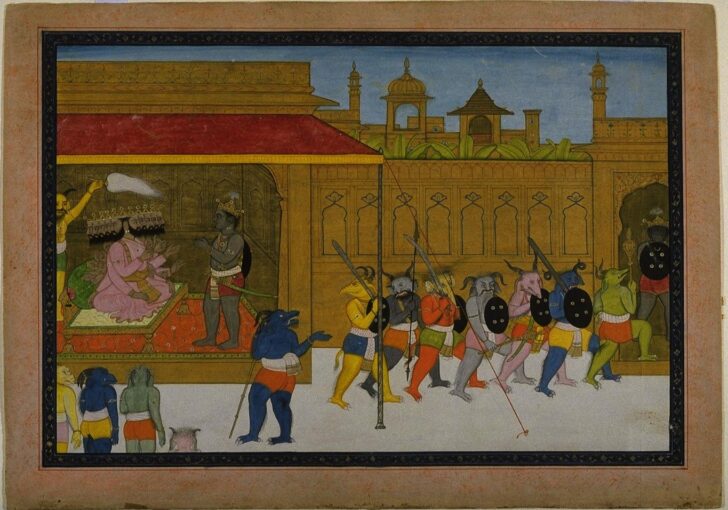Râmâyana manuscript, folio 101: Demon Armies Pour Out of Ravana’s Castle
Artist Unknown, India, Seu-Nainsukh School

Description
The Ramayana is one of the most ancient and enduring epics of Indian literature. The tale revolves around Rama, a human manifestation of the great Hindu god Vishnu. The young prince Rama endures fourteen years of banishment and severe trials before winning restoration to his rightful throne. His antagonist is Ravana, the powerful king of Lanka (modern Sri Lanka), who had abducted Rama’s wife Sita. Rama, his brother Lakshmana, and his wife Sita are emblems of enduring Indian ideals of kingship, duty, and marital fidelity. This painting, one leaf from an extensive series done for a minor prince in the Punjab Hills of northern India, depicts Ravana in his golden castle, sending forth his demon warriors to repel Rama’s attack.
In many versions of the Ramayana, Ravana is portrayed as a personification of evil, with grotesque features. However, other versions cast him as a complex character, one who is at both a just and beloved ruler of Lanka and a ruthless tyrant who ravages the land and people of continental India. This artist has chosen to present Ravana as regal and noble: multiple heads and arms notwithstanding, he is handsome and dignified. Even his demons, with their horns and fangs and animal heads, do not seem so threatening when painted in pastel colors. It is typical of Punjab Hills painters of the eighteenth-century to edit out ugly or terrifying elements in the Ramayana and other tales, preferring a sweeter, more charming mood.
Maribeth Graybill, Senior Curator of Asian Art
Exhibited in "Stories from the Past: Narrative in Asian Art "
January 24–July 25, 2004
Usage Rights:
If you are interested in using an image for a publication, please visit https://umma.umich.edu/request-image/ for more information and to fill out the online Image Rights and Reproductions Request Form.